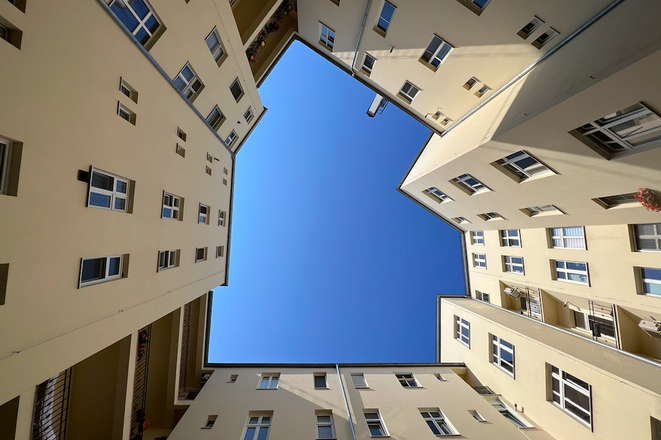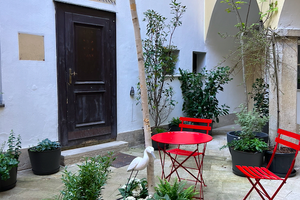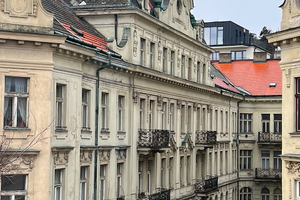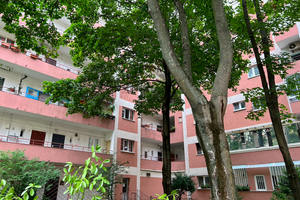One day, in the hope of getting her newborn son to sleep, Lucia Lišková put him in a pushchair and began walking around Bratislava. These walks gradually became her routine, and in the course of them she often caught herself peeking into the courtyards that she passed.
The young mother soon developed something of a penchant for discovering them.
At first, she shared photos of the courtyards in the city just with her friends, via her personal Instagram profile. But they later convinced her to start a public Instagram page to show Bratislava’s courtyards – open-air but often private spaces enclosed by buildings on three or four sides – to many more people.
In Slovak, this architectural feature is referred to as a “vnútroblok” or a “dvor”.
Lišková gradually explored not just courtyards, many of which are not open to people unless they reside in the buildings surrounding them, but also their history and the stories of the people who use them.
“I didn’t expect more than just a few friends to follow the page,” says the mother of two.
Her page, which she has run since April 2022, now has more than 8,000 followers.
A courtyard with a canoe, another with a writer’s bench
In the very first post, she takes her followers to a courtyard on Kupeckého Street, a stone’s throw from the Central shopping mall. Here, people can find the famous Fountain for Zuzana. The fountain, which was initially a prop used in a popular 1980s film shot in this courtyard, has been turned into an actual water feature.
“I really like this courtyard. They’ve got a great playground there,” she told the people who follow her page.
She also shared pictures of the “Krista Bendová Courtyard”. Bendová, a famous Slovak children’s writer, used to live in a flat on Záhrebská Street, close to Slovak Radio’s inverted-pyramid headquarters building.
“I pass the courtyard every week on my way to the open-air market on Žilinská Street,” Lišková explained to her followers, calling it a “wild” courtyard. Visitors can find a bench here that Bendová used to sit on, a birdhouse for books, but also an ornate blue wall. “I’ve never understood why it’s blue.”
Although they have been part of the city’s architecture for centuries, the function of courtyards has changed over time, along with the changing needs and interests of Bratislavans. Many still remember times when they played with their childhood friends in these courtyards or when their parents, or neighbours, used the outdoor spaces for drying clothes and cleaning their carpets, after throwing them over fixed steel frames that can still be spotted around the city. The practice of beating one’s carpets in public, though still seen occasionally, is nowadays vanishing. The same cannot be said about the practice of cars parking in courtyards.
Regardless, courtyards are being turned into spaces that can better serve their local communities after many years of neglect. Revitalised playgrounds and benches, workout zones, small gardens and gazebos are all popping up in the courtyards of Bratislava.
Last summer, the construction company YIT published a manual on how to transform a courtyard into a cosy place.
Despite it containing a small parking lot, a perfect example of a courtyard that serves its community is the one on Kalinčiakova Street, one of Lišková’s favourites. She says that this courtyard was one the reasons she began posting about these open-air spaces on Instagram in the first place. It is full of trees, playgrounds, gardens, small statues, and even a gazebo can be found there.
“But it is not open to the public,” Lišková points out.
Therefore, people can admire a wheelbarrow and a canoe that have both turned into large flower pots, but only on Lišková’s page – unless, as visitors, they are eager enough to get someone to let them into the courtyard.
A courtyard is like a bridge
The courtyard explorer believes that these spaces bring out the best from the residents living around them. It is not the money but rather the time that residents invest in improving courtyards that the Bratislavan appreciates. When she sees flowers or toys in a courtyard, she knows there is a functioning courtyard community.
“The most beautiful courtyards even have a board with notes from neighbours about upcoming activities,” she notes.
Lišková, who also loves interior design, says that by entering a courtyard a visitor can become a part of the local community without invading the privacy of residents who live in the buildings that surround each of these enclosed, open-air spaces.
She describes them as a “bridge between the intimacy of a flat and the street”.
In addition, she receives extra bonus sights during her trips around courtyards in the form of different staircases, tiles, doors and balconies.
“I enjoy each of these surprises because I never know what lies behind the gate,” she says. “Opening it feels like unwrapping a Christmas present.”
Speaking of Christmas, Lišková recalls her visit to a closed courtyard on Osadná Street in the Nové Mesto borough. She says that she really felt the presence of the local community. She was even told that residents there practise yoga and hold legendary Christmas gatherings. But the story of these old blocks of flats, built in 1913, is also interesting. They were erected with financial help from Slovak Americans for poor people who had lost their homes in fires.
Lišková herself lives in a block of flats with a courtyard in Nové Mesto.
From cosy to massive outdoor spaces
In Nové Mesto, isolated and safe courtyards built in the interwar and postwar periods are typical. Similar courtyards are located in the Old Town. Conversely, in the Petržalka borough, the construction of which began under communism in 1973, courtyards feel uniform and massive.
“There is boundless anonymity” in Petržalka, architect Igor Lichý told the Eurostav magazine in 2021. “It is not clear what belongs to which object. Everything is everyone’s.”
Traditional courtyards began to reappear in Bratislava in the eighties, according to history and urbanism populariser Ivor Švihran. He added that this was how an interesting block of flats came about between Grösslingová and Gajová Streets. Lišková herself has shared several posts of courtyards from Grösslingová Street – one of the longest streets in the Old Town, known as Red Army Street in the second half of the 20th century – underlining that some courtyards on this street still have untapped potential.
And while she cannot change how these neglected courtyards look, Lišková is determined to continue drawing people’s attention to them, and to many other courtyards that are waiting to be discovered.
“It is the reactions of my followers, including numerous invitations to their courtyards, that still motivates me.”
Author: Zuzana Rusnáková, Hana Trenčanová


 One of many Bratislava courtyards. (source: Courtesy of Lucia Lišková)
One of many Bratislava courtyards. (source: Courtesy of Lucia Lišková)


